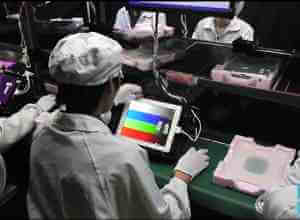An Exclusive Look Inside The Foxconn Factory That Makes iPads

Share
Shenzhen China is home to one of the world’s largest – and most talked about – factories. It is where the Longhua facility of Foxconn is driven by the manpower of a 240,000 person workforce, nearly all of them migrant workers from the Chinese countryside. The facility and its workers have come under scrutiny in recent months after a series of disturbing reports that included sweatshop-like conditions and hours, an explosion that killed three, underage workers, and 14 suicides.
Also under scrutiny is Apple whose iPads are assembled at the Foxconn factory.
Rob Schmitz, correspondent for Marketplace China, recently visited the beleaguered factory and got a glimpse of the people and machines that put our iPads together.
The first step in the assembly line is where the motherboards are assembled. Here a machine attaches a tiny buckle to the motherboard, a kind of ID tag so that if something is found faulty with the motherboard they can trace it back to when and where it was assembled. Other machines help the workers to install the battery, LED display, and other components. Once assembled, the iPad is placed in devices that test its display and its gyroscope. The vast majority of tasks take the workers just seconds to complete. When a task is completed, the iPad is scanned, a computer says, “OK,” and the iPad is passed on to the next station. This sequence is repeated thousands of times a day.
Ninety-nine percent of workers at the plant are migrant workers, traveling from the Chinese countryside in search of higher pay. That’s a relative term, of course, as the starting wage at one Foxconn assembly line is about $14 a day. But that’s a high wage, at least compared to Chinese garment factories where workers make just over $100 per month. And at Foxconn their salary will double after two years. Assembly lines are tedious work by definition, and the Foxconn workers rotate to different stations every few days.
You can read Schmitz’s accompanying article about “The People Behind Your iPad” here.
Be Part of the Future
Sign up to receive top stories about groundbreaking technologies and visionary thinkers from SingularityHub.


Perhaps in part in response to international criticism, in part to increase efficiency, China plans on replacing many of the workers at the Foxconn facility with robots. But even now it is already clear that Foxconn has produced two efficient and robust machines.
[image credits: marketplacevideos via YouTube]
[video credit: marketplacevideos via YouTube]
images: Foxconn
video: Foxconn
Peter Murray was born in Boston in 1973. He earned a PhD in neuroscience at the University of Maryland, Baltimore studying gene expression in the neocortex. Following his dissertation work he spent three years as a post-doctoral fellow at the same university studying brain mechanisms of pain and motor control. He completed a collection of short stories in 2010 and has been writing for Singularity Hub since March 2011.
Related Articles

How Scientists Are Growing Computers From Human Brain Cells—and Why They Want to Keep Doing It

These Brain Implants Are Smaller Than Cells and Can Be Injected Into Veins

This Wireless Brain Implant Is Smaller Than a Grain of Salt
What we’re reading
